washer fluid Lexus IS250 2006 Using the audio system / LEXUS 2006 IS350/250 THROUGH APRIL 2006 PROD. OWNER'S MANUAL (OM53508U)
[x] Cancel search | Manufacturer: LEXUS, Model Year: 2006, Model line: IS250, Model: Lexus IS250 2006Pages: 433, PDF Size: 10.9 MB
Page 137 of 433
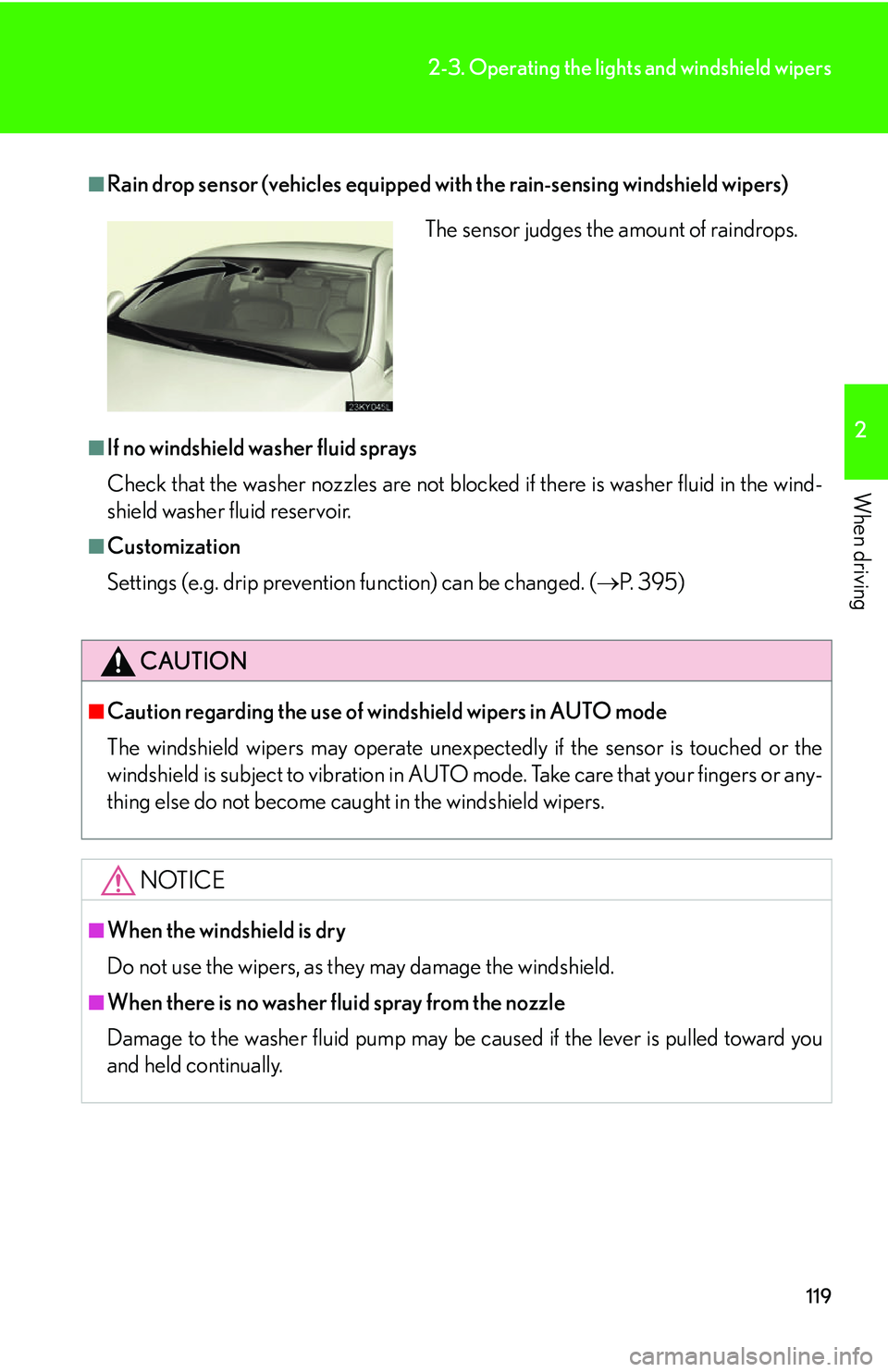
119
2-3. Operating the lights and windshield wipers
2
When driving
■Rain drop sensor (vehicles equipped with the rain-sensing windshield wipers)
■If no windshield washer fluid sprays
Check that the washer nozzles are not blocked if there is washer fluid in the wind-
shield washer fluid reservoir.
■Customization
Settings (e.g. drip prevention function) can be changed. ( P. 3 9 5 )
CAUTION
■Caution regarding the use of windshield wipers in AUTO mode
The windshield wipers may operate unexpectedly if the sensor is touched or the
windshield is subject to vibration in AUTO mode. Take care that your fingers or any-
thing else do not become caugh t in the windshield wipers.
NOTICE
■When the windshield is dry
Do not use the wipers, as they may damage the windshield.
■When there is no washer fluid spray from the nozzle
Damage to the washer fluid pump may be caused if the lever is pulled toward you
and held continually.
The sensor judges the amount of raindrops.
Page 138 of 433

120
2-3. Operating the lights and windshield wipers
Headlight cleaner switch (if equipped)
■The headlight cleaner can be operated when
When the engine switch is in IG-ON mode and the headlight switch is turned ON.
NOTICE
■When the washer fluid tank is empty
Do not use this function when the washer fluid tank is empty. This may cause the
washer fluid pump to overheat.
Washer fluid can be sprayed on the headlights.
Press the switch to clean the
headlights.
Page 169 of 433
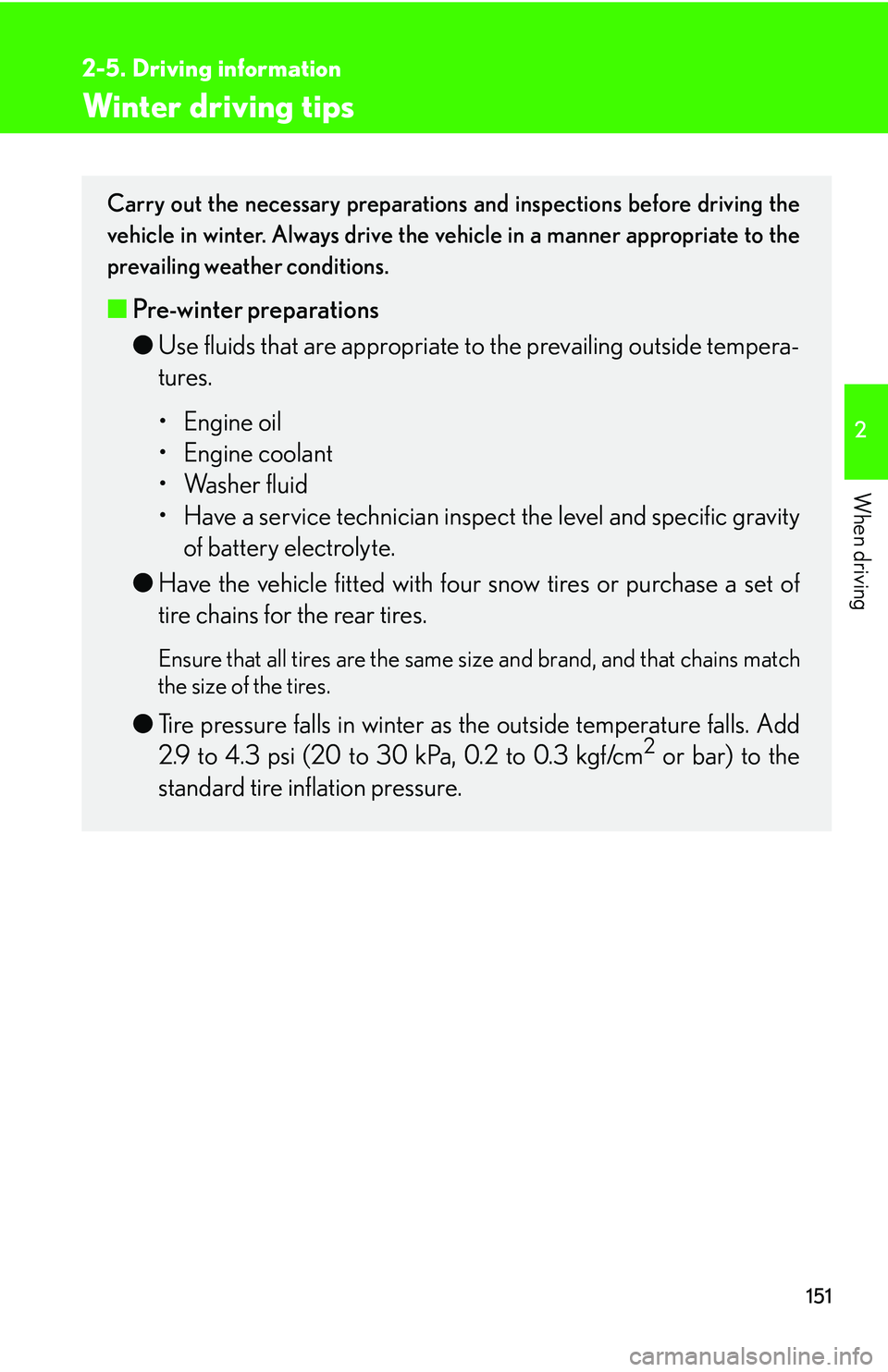
151
2-5. Driving information
2
When driving
Winter driving tips
Carry out the necessary preparations and inspections before driving the
vehicle in winter. Always drive the vehicle in a manner appropriate to the
prevailing weather conditions.
■ Pre-winter preparations
●Use fluids that are appropria te to the prevailing outside tempera-
tures.
• Engine oil
• Engine coolant
• Washer fluid
• Have a service technician inspect the level and specific gravity
of battery electrolyte.
● Have the vehicle fitted with four snow tires or purchase a set of
tire chains for the rear tires.
Ensure that all tires are the same size and brand, and that chains match
the size of the tires.
● Tire pressure falls in winter as the outside temperature falls. Add
2.9 to 4.3 psi (20 to 30 kPa, 0.2 to 0.3 kgf/cm2 or bar) to the
standard tire inflation pressure.
Page 274 of 433
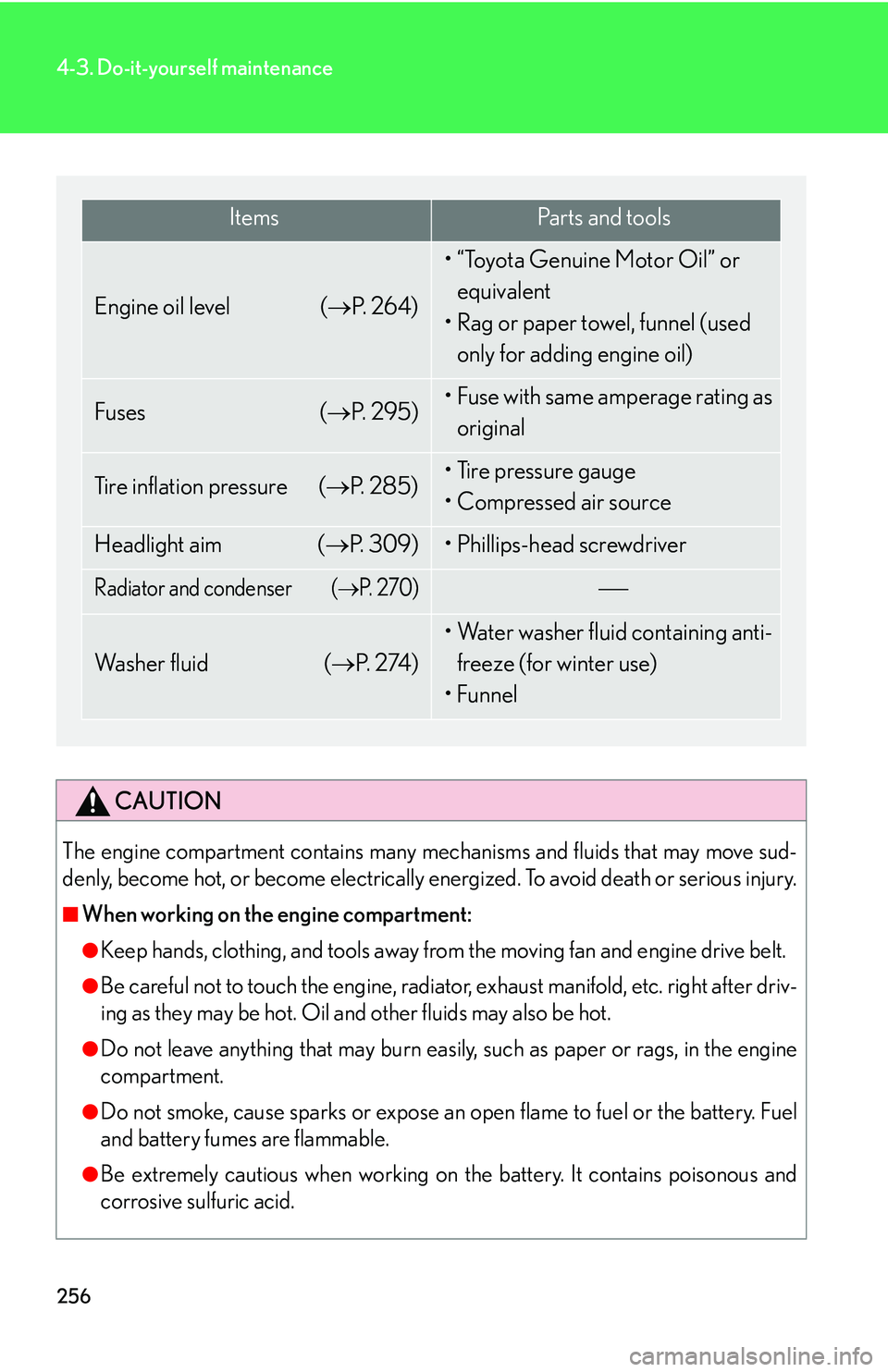
256
4-3. Do-it-yourself maintenance
CAUTION
The engine compartment contains many mechanisms and fluids that may move sud-
denly, become hot, or become electrically energized. To avoid death or serious injury.
■When working on the engine compartment:
●Keep hands, clothing, and tools away from the moving fan and engine drive belt.
●Be careful not to touch the engine, radiator , exhaust manifold, etc. right after driv-
ing as they may be hot. Oil and other fluids may also be hot.
●Do not leave anything that may burn easi ly, such as paper or rags, in the engine
compartment.
●Do not smoke, cause sparks or expose an open flame to fuel or the battery. Fuel
and battery fumes are flammable.
●Be extremely cautious when working on the battery. It contains poisonous and
corrosive sulfuric acid.
ItemsPa r t s a n d t o o l s
Engine oil level ( P. 2 6 4 )
• “Toyota Genuine Motor Oil” or
equivalent
• Rag or paper towel, funnel (used only for adding engine oil)
Fuses ( P. 2 9 5 )• Fuse with same amperage rating as
original
Tire inflation pressure ( P. 2 8 5 )• Tire pressure gauge
• Compressed air source
Headlight aim ( P. 3 0 9 )• Phillips-head screwdriver
Radiator and condenser (P. 2 7 0 )
Wa s h e r f l u i d ( P. 2 74 )
• Water washer fluid containing anti-
freeze (for winter use)
•Funnel
Page 279 of 433
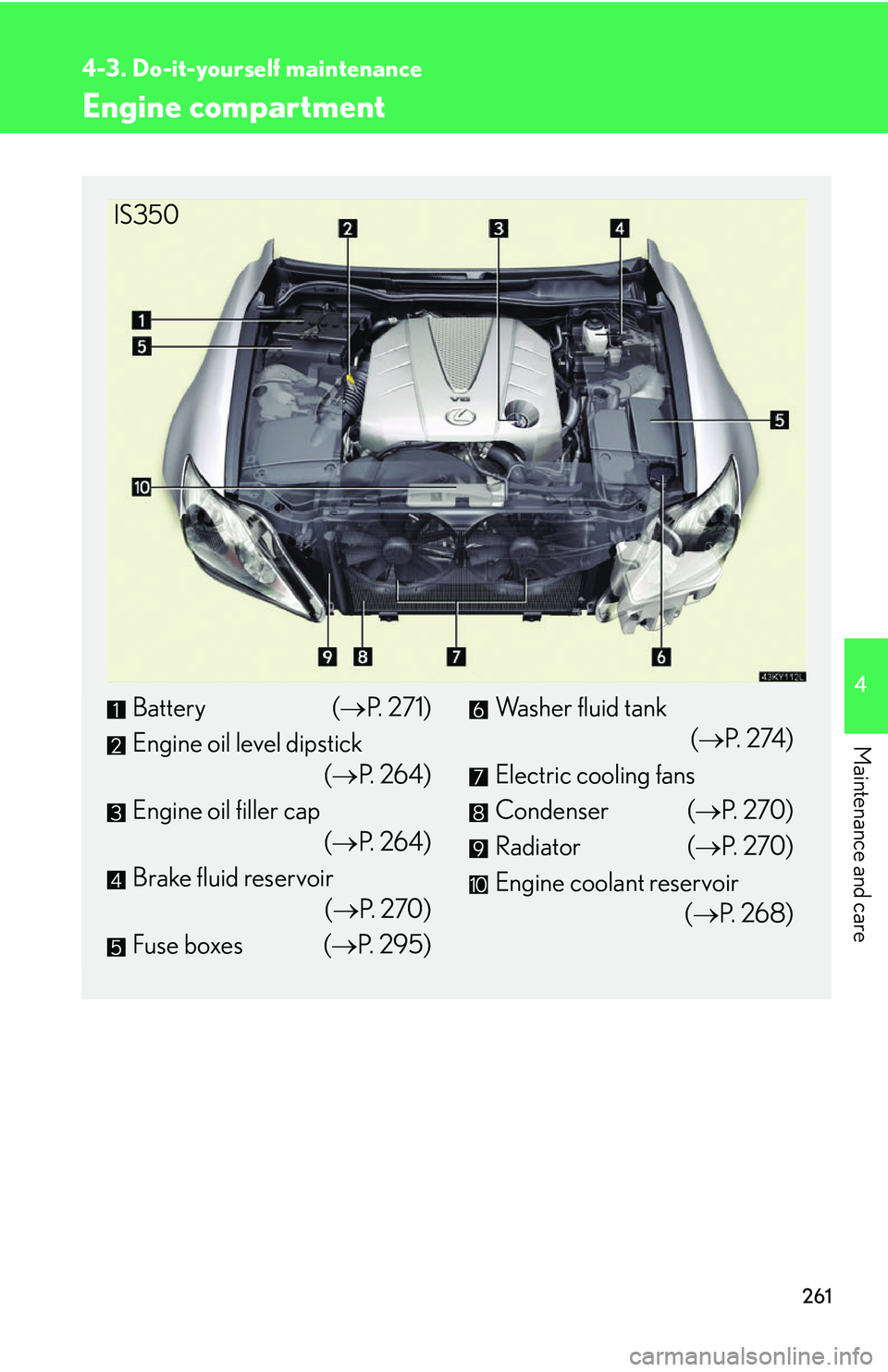
261
4-3. Do-it-yourself maintenance
4
Maintenance and care
Engine compartment
Battery (P. 271)
Engine oil level dipstick (P. 2 6 4 )
Engine oil filler cap (P. 2 6 4 )
Brake fluid reservoir (P. 270)
Fuse boxes ( P. 295)Washer fluid tank
(P. 2 74 )
Electric cooling fans
Condenser ( P. 2 7 0 )
Radiator ( P. 2 7 0 )
Engine coolant reservoir (P. 2 6 8 )
IS350
Page 280 of 433
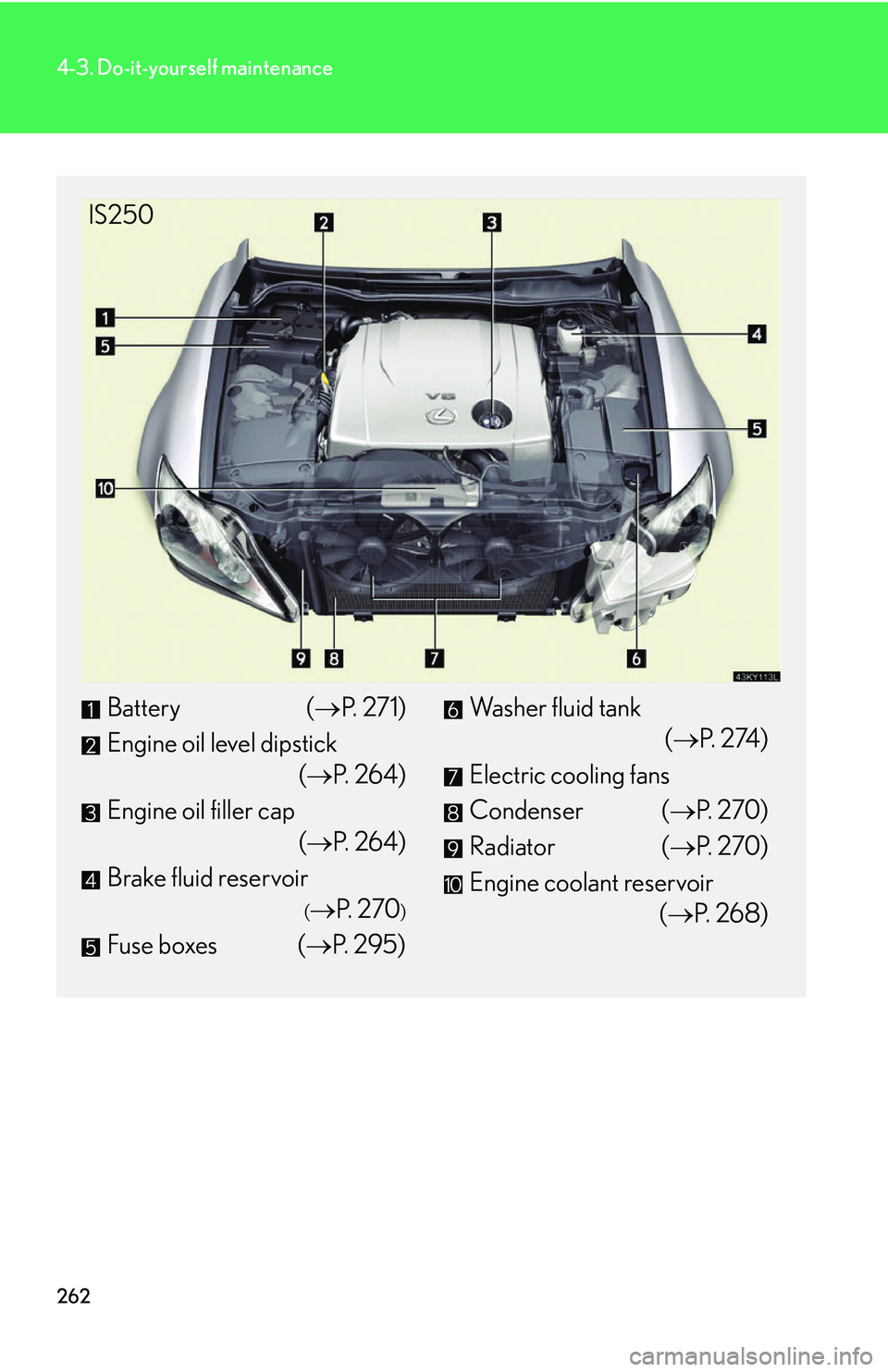
262
4-3. Do-it-yourself maintenance
Battery (P. 271)
Engine oil level dipstick (P. 2 6 4 )
Engine oil filler cap (P. 2 6 4 )
Brake fluid reservoir
( P. 2 7 0)
Fuse boxes ( P. 295)
Washer fluid tank
(P. 2 74 )
Electric cooling fans
Condenser ( P. 2 7 0 )
Radiator ( P. 2 7 0 )
Engine coolant reservoir (P. 2 6 8 )
IS250
Page 292 of 433

274
4-3. Do-it-yourself maintenance
Washer fluidIf any washer does not work or the
warning message appears on the
multi-information display, the
washer tank may be empty. Add
washer fluid.
NOTICE
■When recharging the battery
Never recharge the battery while the engine is running. Also, be sure all accesso-
ries are turned off.
NOTICE
■Do not use any fluid other than washer fluid
Do not use soapy water or engine antifreeze instead of washer fluid.
Doing so may cause streaking on the vehicle’s painted surfaces.
■Diluting washer fluid
Dilute washer fluid with water as necessary.
Refer to the freezing temperatures listed on the washer fluid tank.
Page 333 of 433
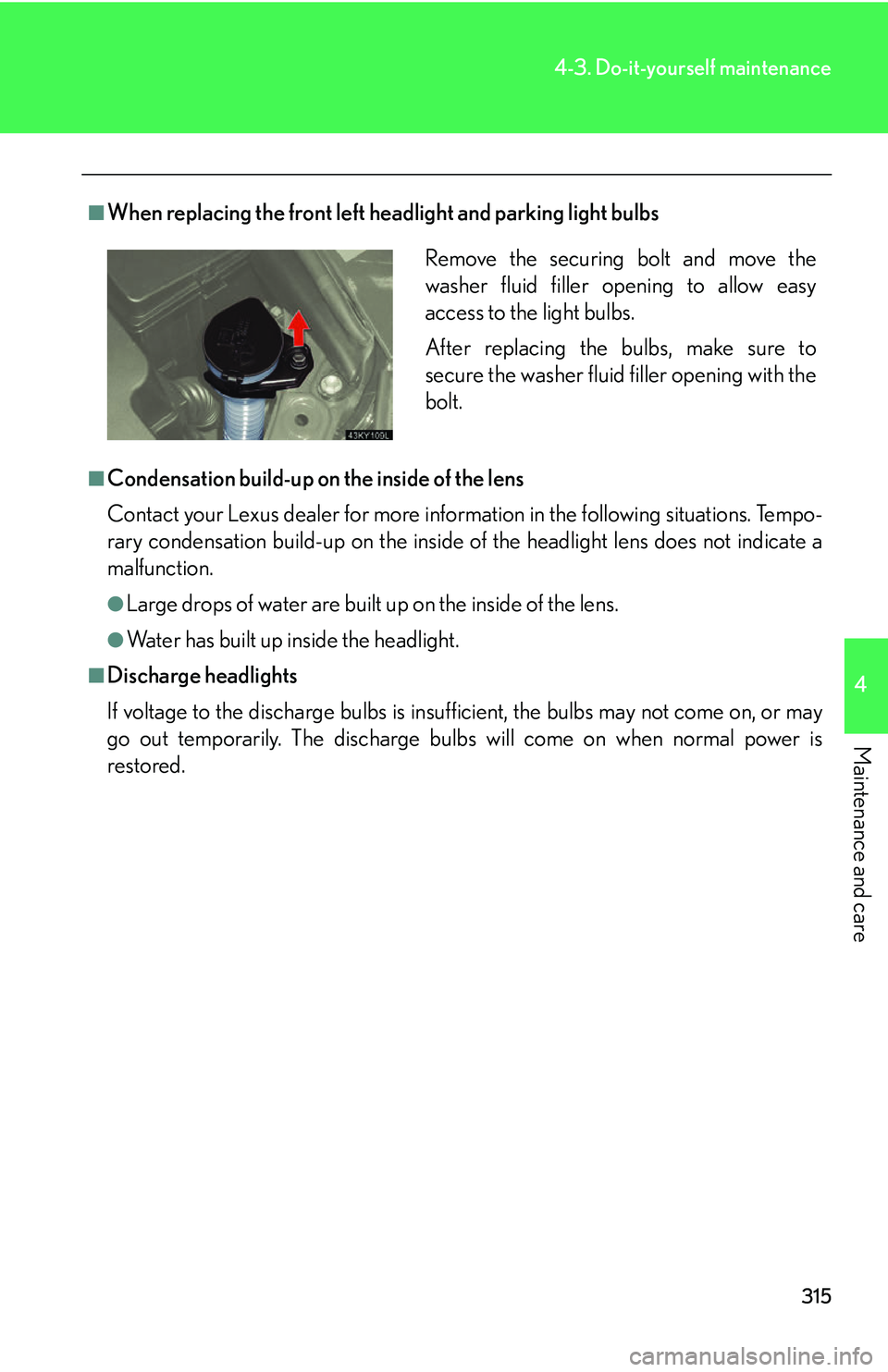
315
4-3. Do-it-yourself maintenance
4
Maintenance and care
■When replacing the front left headlight and parking light bulbs
■Condensation build-up on the inside of the lens
Contact your Lexus dealer for more inform ation in the following situations. Tempo-
rary condensation build-up on the inside of the headlight lens does not indicate a
malfunction.
●Large drops of water are built up on the inside of the lens.
●Water has built up in side the headlight.
■Discharge headlights
If voltage to the discharge bulbs is insufficient, the bulbs may not come on, or may
go out temporarily. The discharge bulbs will come on when normal power is
restored.
Remove the securing bolt and move the
washer fluid filler opening to allow easy
access to the light bulbs.
After replacing the bulbs, make sure to
secure the washer fluid filler opening with the
bolt.
Page 358 of 433

340
5-2. Steps to take in an emergency
Wa r n i n g m e s s a g eDetailsCorrection procedure
Indicates that the trunk is
not fully closed. flashes and a
buzzer sounds to indi-
cate that trunk is not fully
closed (with the vehicle
having reached a speed
of 3mph [5km/h]).
Close the trunk.
(Flashing)
Indicates that the moon
roof is not fully closed
(with the engine switch
OFF and the driver’s
door opened).
Close the moon roof.
(Flashing)
Indicates that the parking
brake is still engaged
(with the vehicle having
reached a speed of more
than 3 mph [5 km/h]).
Release the parking
brake.
Indicates that the washer
fluid level is low.Add washer fluid.
Page 424 of 433
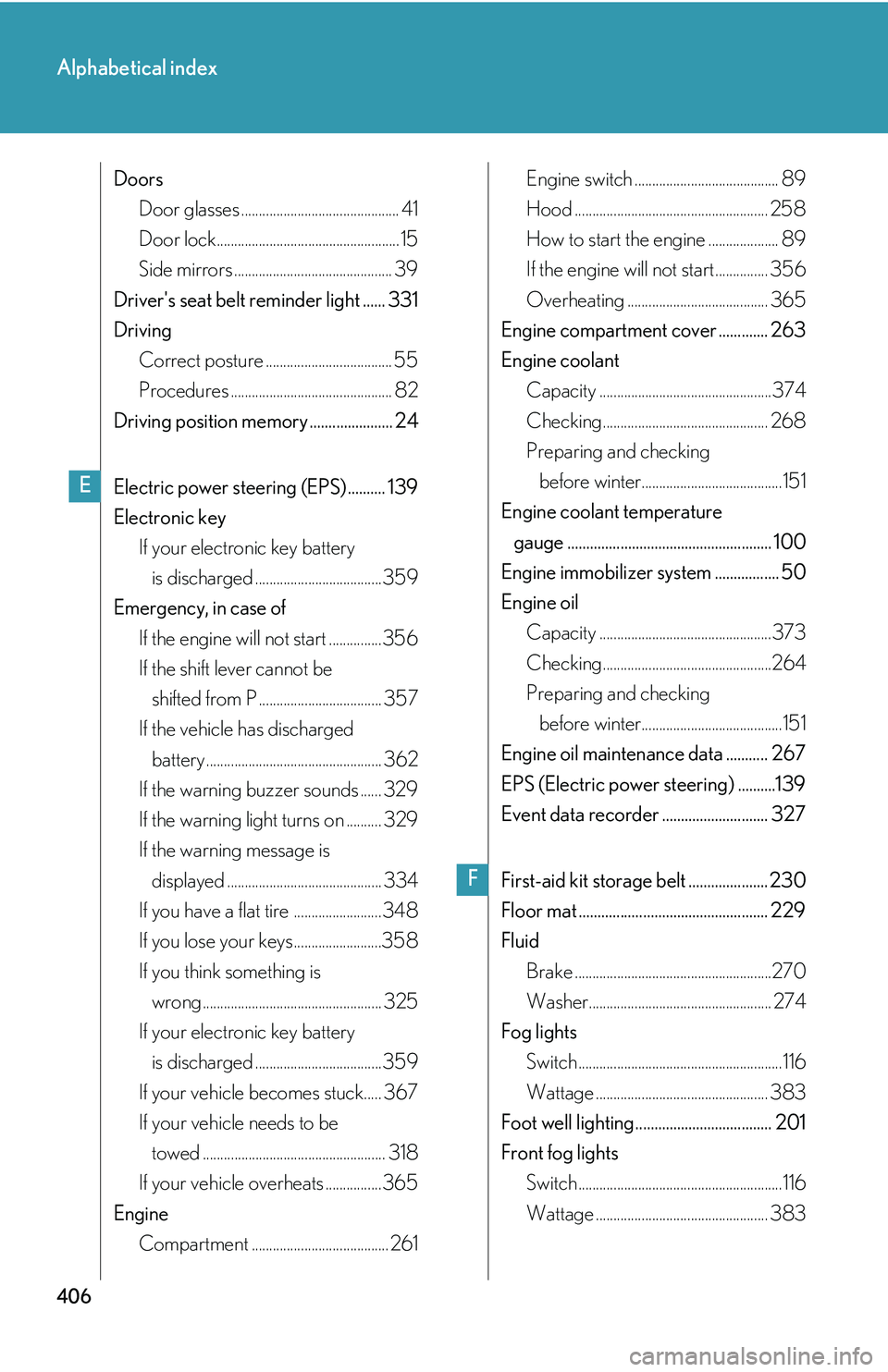
406
Alphabetical index
DoorsDoor glasses ............................................. 41
Door lock.................................................... 15
Side mirrors ............................................. 39
Driver's seat belt reminder light ...... 331
Driving Correct posture .................................... 55
Procedures .............................................. 82
Driving position memory ...................... 24
Electric power steering (EPS).......... 139
Electronic key If your electronic key battery is discharged ....................................359
Emergency, in case of If the engine will not start ...............356
If the shift lever cannot be shifted from P ................................... 357
If the vehicle has discharged battery .................................................. 362
If the warning buzzer sounds ...... 329
If the warning light turns on .......... 329
If the warning message is
displayed ............................................ 334
If you have a flat tire .........................348
If you lose your keys.........................358
If you think something is wrong ................................................... 325
If your electronic key battery is discharged ....................................359
If your vehicle becomes stuck..... 367
If your vehicle needs to be towed .................................................... 318
If your vehicle overheats ................365
Engine Compartment ....................................... 261 Engine switch ......................................... 89
Hood ....................................................... 258
How to start the engine .................... 89
If the engine will not start ............... 356
Overheating ........................................ 365
Engine compartment cover ............. 263
Engine coolant Capacity .................................................374
Checking............................................... 268
Preparing and checking before winter........................................151
Engine coolant temperature gauge ...................................................... 100
Engine immobilizer system ................. 50
Engine oil Capacity .................................................373
Checking................................................264
Preparing and checking before winter........................................151
Engine oil maintenance data ........... 267
EPS (Electric power steering) ..........139
Event data recorder ............................ 327
First-aid kit storage belt ..................... 230
Floor mat .................................................. 229
Fluid Brake ........................................................270
Washer.................................................... 274
Fog lights Switch .......................................................... 116
Wattage ................................................. 383
Foot well lighting.................................... 201
Front fog lights Switch .......................................................... 116
Wattage ................................................. 383
E
F